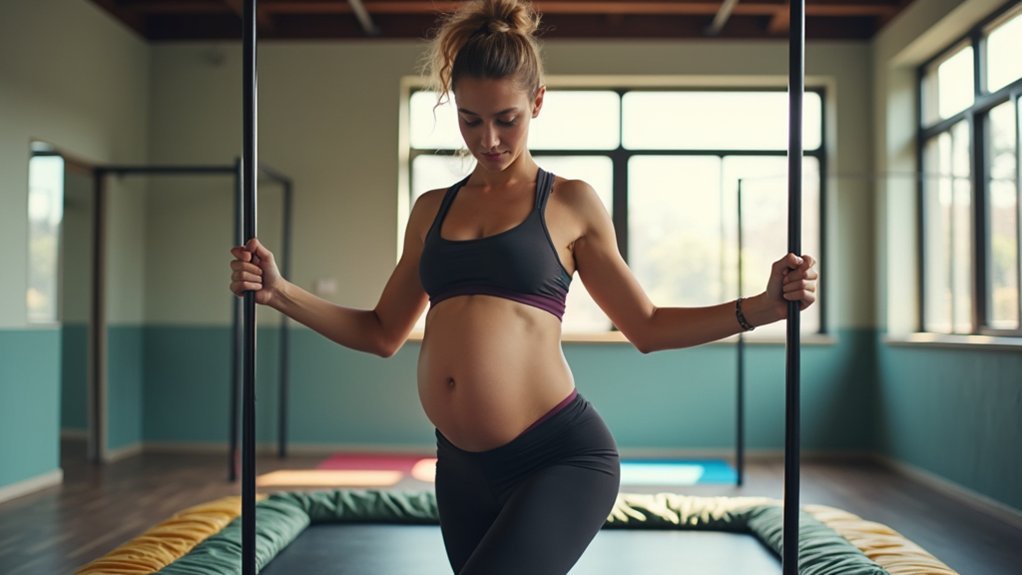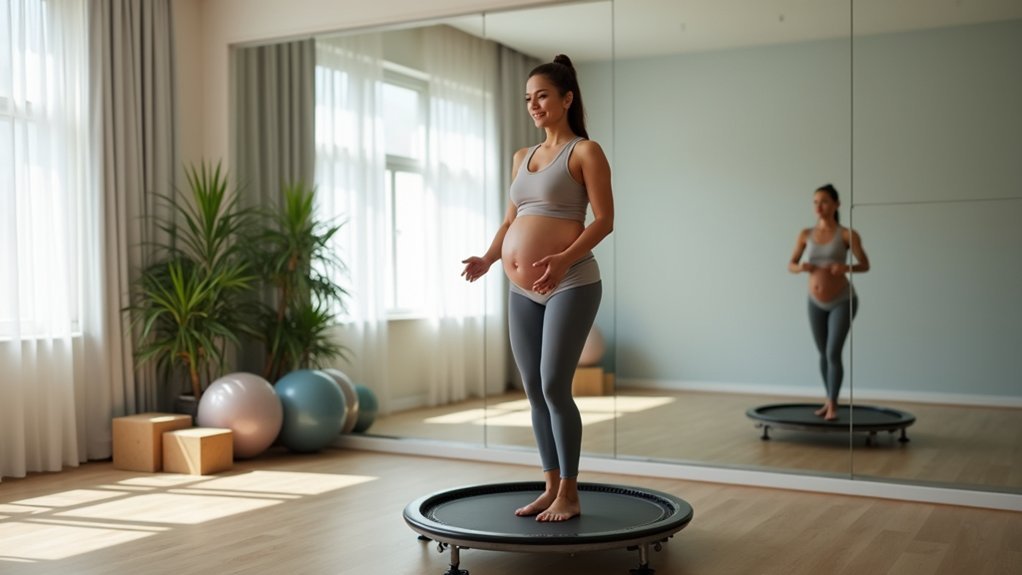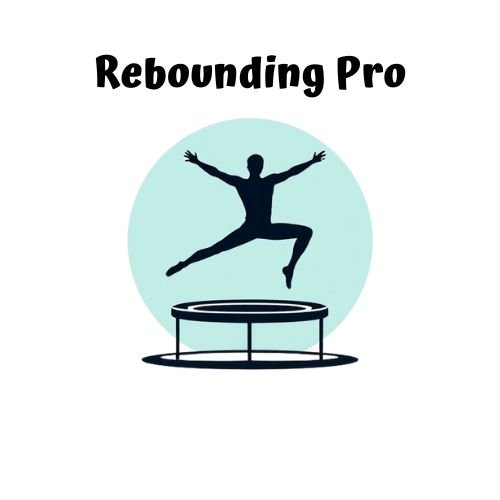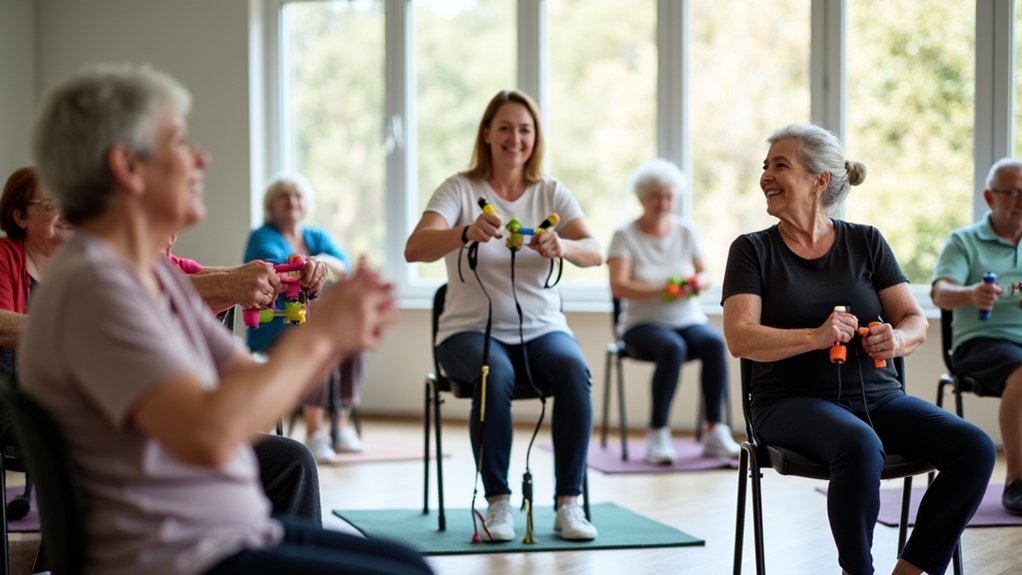When rebounding during pregnancy, you’ll need these key balance modifications: hold the side rails for stability, widen your stance for a stronger base, reduce your bounce height as your center of gravity shifts, use wall support for challenging movements, and wear a pregnancy support band for added stabilization. Always consult your doctor before starting and modify as your pregnancy progresses. These simple adjustments will help you enjoy safe, effective workouts throughout your pregnancy journey.
Holding Side Rails for Enhanced Stability During Pregnancy

As your pregnancy progresses, holding side rails during workouts becomes essential for maintaining safety and proper form. They help minimize your fall risk by stabilizing your shifting center of gravity while providing significant proprioceptive feedback as your body changes.
Proper rail support compensates for pregnancy’s shifting balance, creating a safer exercise environment as your body transforms.
When you grip the rails, you’re effectively mitigating G-forces during bouncing movements, protecting your joints through upper body load-sharing, and reducing downward pressure on your pelvic floor. This strategic hand placement allows you to maintain proper postural alignment with a neutral spine during lateral movements.
For best results, adjust rail height to your trimester needs and experiment with grip variations to prevent fatigue.
Remember to watch for signs of overexertion like trembling hands. The GeForce of 2-6 G’s during rebounding could have unknown effects on your baby, making stabilization particularly important. Always consult your obstetrician before starting any pregnancy exercise routine, as they can provide personalized guidance for your specific condition.
Widening Your Stance for a Stronger Base of Support
Widening your stance on a rebounder creates a more stable foundation for your pregnancy workouts. As your center of gravity shifts, this broader base helps counteract balance challenges while reducing the risk of falls during exercise.
Here’s how a wider stance benefits your pregnancy rebounding routine:
- Enhances stability by providing a stronger base that accommodates your changing body and helps you feel more confident during movement.
- Promotes proper alignment by distributing weight evenly and encouraging better posture.
- Facilitates fluid shifts between exercises, allowing for smoother, more controlled movements.
- Reduces joint pressure by spreading impact across more muscle groups and creating a more balanced distribution of weight.
Remember that individual considerations are paramount when determining if rebounding is right for your pregnancy journey, as each woman’s body responds differently to exercise during this special time.
Reducing Bounce Height as Your Center of Gravity Shifts

Your growing baby bump naturally shifts your center of gravity forward during pregnancy, making high bounces on a rebounder increasingly challenging and potentially risky.
As your abdomen expands, your body creates a sway-back posture to maintain stability, but this adjustment affects your balance during dynamic movements.
Lower your bounce height to compensate for these biomechanical changes. Smaller, controlled bounces help maintain stability while still providing cardiovascular benefits.
You’ll reduce joint stress and minimize fall risks by keeping movements closer to the mat surface.
Focus on gentle, rhythmic bouncing rather than explosive jumps. This modification works with your changing body mechanics rather than against them.
Your nervous system will thank you for these adjustments, as they allow it to better coordinate muscle activity for stability despite your continuously shifting center of gravity.
This approach is especially important in the final trimester when your waddling gait pattern develops, making balance more precarious during rebounding exercises.
Incorporating Wall Support for Balance-Challenging Movements
The wall becomes your most valuable ally when balance grows increasingly challenging during pregnancy. It provides immediate stability during weight shifts while allowing you to maintain proper form during dynamic movements. For maximum safety, use the three-point contact principle—keeping two feet and one hand connected to the wall when attempting more complex exercises. Always consult with your healthcare provider before beginning any new exercise regimen during pregnancy.
- Position yourself back-to-wall for pelvic anchoring during lateral movements and arm swings.
- Try wall-assisted squats to prevent forward leaning while keeping your core and glutes properly engaged.
- Practice wall angels to counteract rounded shoulders from pregnancy-related breast changes.
- Integrate resistance bands anchored at wall height for upper-body strengthening without compromising stability.
Gradually reduce wall dependence through progressive disengagement—from full support to single-hand touch to independent movement—as your confidence with your changing body increases.
Using Pregnancy Support Bands While Rebounding

Pregnancy support bands provide essential stabilization when incorporating rebounding exercises into your prenatal fitness routine. They’re particularly effective for enhancing your overall stability while reducing excessive bounce movement on the rebounder. Back and joint pain affects a significant majority of pregnant women, and belly bands stabilize the sacroiliac joint during bouncing movements.
| Benefit | Application During Rebounding |
|---|---|
| Enhanced Support | Reduces abdominal and back strain |
| Improved Stability | Minimizes excessive bouncing |
| Pain Relief | Alleviates lower back discomfort |
| Modified Intensity | Enables safer workout adaptations |
Don’t rely solely on these bands—combine them with proper breathing techniques and posture corrections for maximum effectiveness. While they’ll help you maintain balance on the rebounder, remember they’re temporary solutions. As your pregnancy progresses, you’ll need to adjust your band to accommodate your changing body while continuing to strengthen your core through appropriate exercises.
Frequently Asked Questions
When Should I Stop Rebounding Completely During Pregnancy?
You should stop rebounding completely if you experience dizziness, vaginal bleeding, contractions, shortness of breath, or during the third trimester when your balance markedly changes. Always follow your doctor’s specific recommendations.
Can Rebounding Cause Diastasis Recti in Pregnant Women?
Yes, rebounding can potentially worsen diastasis recti during pregnancy due to increased intra-abdominal pressure. You’ll need to modify your routine or consider alternatives if you’re pregnant or have abdominal separation.
How Soon After Delivery Can I Resume Normal Rebounding?
You’ll need to wait at least 12 weeks postpartum before resuming normal rebounding, and you should get medical clearance first. Start gradually after your pelvic floor and core muscles have properly healed.
Are There Specific Shoes Recommended for Pregnancy Rebounding?
Look for shoes with supportive arches, cushioned midsoles, and wide toe boxes. You’ll want running sneakers like Brooks Adrenaline or slip-on options with secure heel counters. Avoid backless shoes or high heels completely.
Will Rebounding Affect My Pelvic Floor During Pregnancy?
Yes, rebounding can impact your pelvic floor during pregnancy. You’ll face increased strain from repetitive movements. Get evaluated by a women’s health PT first and consider low-impact modifications or seated rebounding instead.
In Summary
Remember, your safety is paramount as your body changes during pregnancy. You’ll find that these five simple adjustments to your rebounding routine can make all the difference in maintaining balance and stability. Listen to your body, don’t push beyond comfort, and adapt these modifications as needed throughout your pregnancy journey. With proper precautions, you can continue enjoying the gentle, low-impact benefits of rebounding safely.





Leave a Reply